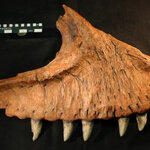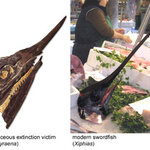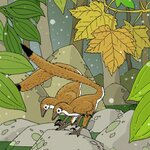Paleontology

(I'm quite tired now, but just wanted to note this down. This ain't science; it's just a diary.)
As it says in my profile, I'm a volunteer part-time fossil preparator for the Dallas Museum of Nature and Science. It's a wonderful avocation, and for the past 2 1/2 years (give or take a month), I've been at work scribing limestone off an Alamosaurus cervical vertebra.
Yes, it probably sounds boring, but deeply intriguing to me.
I know something about comparative vertebrate anatomy, since I took it last century and earlier this century I taught human anatomy labs and was a…

Dracula is back. Turns out he's a fake! Or at least a fake vampire-like fish. A newly discovered freshwater carp-like minnow has been aptly named, Danionella Dracula, for it's vampire-like “teeth.”
These would-be fangs are actually part of a redeveloped jaw structure that give the wee freshwater fellow a vampire appearance. This is not the first time Danionella Dracula has developed this feature. They had "vampire-teeth" years ago, were absorbed in their evolution and then spent the past 30 million years redeveloping.

A surprisingly warm sunny morning sparked a return trip to the Cretaceous-Jurassic exposures near Harrison Lake, British Columbia. The lake and hotsprings at Harrison are an easy one to two hour drive from Vancouver. My work leads me a ways past the town exploring logging roads along the lake.
Without goggles you could easily lose an eye working the unyielding siltstones. Much of my collecting was spent wincing as small, bullet-like projectiles went pinging past my face… others making contact but not enough to deter my efforts. No pain no gain.
After a few hours of work I've done pretty…

Afraid of being eaten alive? Most folks are. Lucky for those living in Nigeria today the dinosaurs went extinct some 65 million years ago. Had they lived on, one of the fiercest meat-eating killers on the planet would be wreaking havoc in Africa.
Those frightening killers do live on in the fossil record, though the record is sparse. Evidence of 95-million year old therapods from Africa is quite scare making one think that each fragment would be treated like gold, this was not the case the first evidence of Carcharodontosaurus iguidensis, a newly described dinosaur from the Cenomanian…

It wouldn't seem logical today that big predators are at the greatest risk for extinction, but they are, and a group of researchers sees a number of similarities between extinctions of 65 million years ago and today.
Studies of modern fishes demonstrate that large body size is linked to large prey size and low rates of population growth, while fast-closing jaws appear to be adaptations for capturing agile, evasive prey—in other words, other fishes. The fossil record provides some remarkable evidence supporting these estimates of function: fossil fishes with preserved stomach contents that…

Scientists from Sweden’s Uppsala University have pieced together a bizarre marine predator who trolled the seas some 505-million years ago. Hurdia, an extinct species of anomalocaridid, had a giant head, protruding hollow spike-shaped head shield and spiny claws for capturing prey. Bits and pieces of Hurdia have shown up in museums all over the world. Until now, much like their more robust cousin, Anomalocaris, they’ve been left unidentified or wildly mislabeled. Allison Daley, the lead author on the study, is happy to set the record straight and will publish the groups findings in this month…

Hurdia victoria was originally described in 1912 as a crustacean-like animal. Now, researchers reveal it to be just one part of a complex and remarkable new animal that has an important story to tell about the origin of the largest group of living animals, the arthropods.
The fossil fragments puzzled together come from the famous 505 million year old Burgess Shale, a UNESCO World Heritage Site in British Columbia, Canada. Uppsala researchers Allison Daley and Graham Budd at the Department of Earth Sciences, together with colleagues in Canada and Britain, describe the convoluted history and…

You know what an octopus is, the eight arms, suckers, and sack-like body are almost as familiar to people as cats or dogs. If you're reading this, you also have enough science to know that soft tissue fossils are very rare because usually only hard objects can survive the somewhat lottery-winning odds of fossilizing at all. The body of an octopus is composed almost entirely of muscle and skin, and when an octopus dies, it quickly decays and liquefies into a slimy blob. After just a few days there will be nothing left at all. But people do win the lottery and some new finds of 95…

Massive predators like Albertosaurus and Tyrannosaurus rex may have been at the top of the food chain, but they were not the only meat-eating dinosaurs to roam North America, according to Canadian researchers who have discovered the smallest dinosaur species on the continent to date. Their work is also helping re-draw the picture of North America's ecosystem at the height of the dinosaur age 75 million years ago.
In a paper published today in Proceedings of the National Academy of Sciences, Nick Longrich, a paleontology research associate in the University of Calgary's Department of…

A herd of young birdlike dinosaurs met their death on the muddy margins of a lake some 90 million years ago, according to a team of Chinese and American paleontologists that excavated a site in the Gobi Desert in western Inner Mongolia. The sudden death of the herd in a mud trap provides a rare snapshot of social behavior. Composed entirely of juveniles of a single species of ornithomimid dinosaur (Sinornithomimus dongi), the herd suggests that immature individuals were left to fend for themselves when adults were preoccupied with nesting or brooding.
Within an exquisite pair of the…